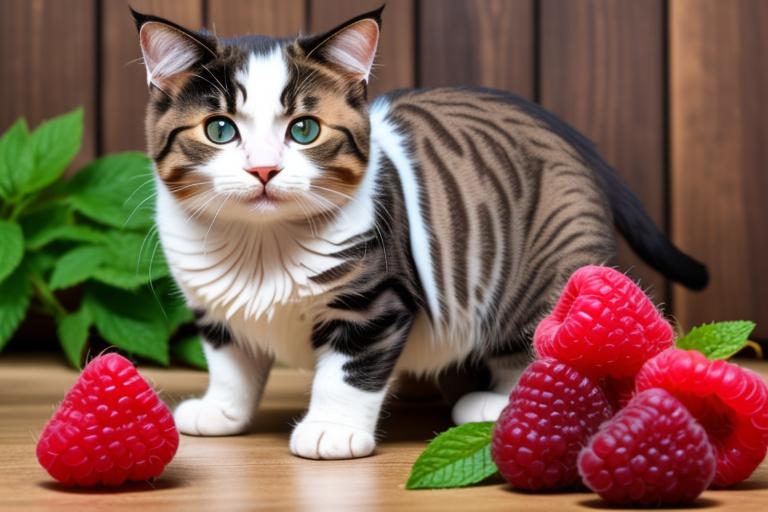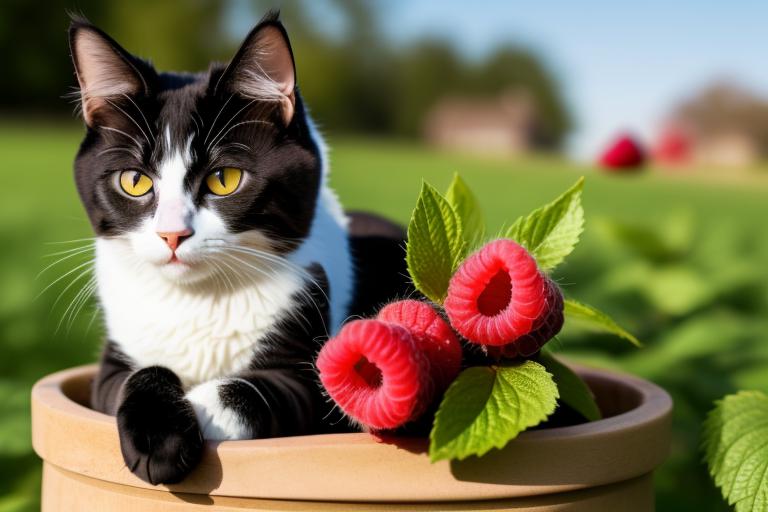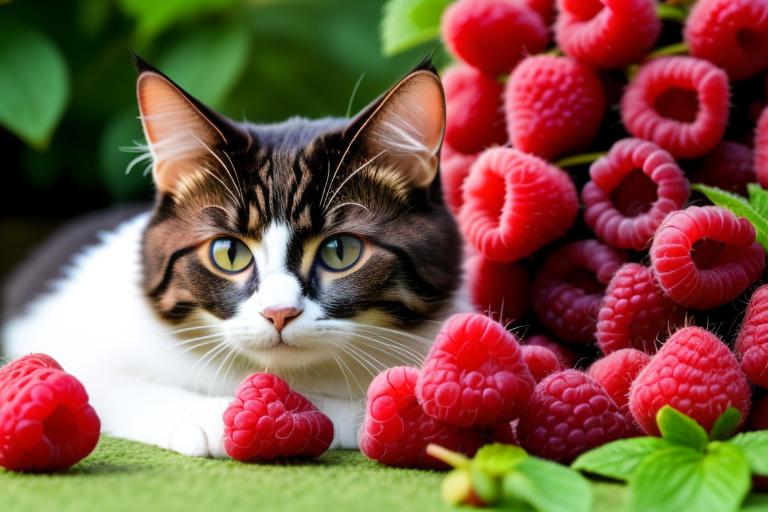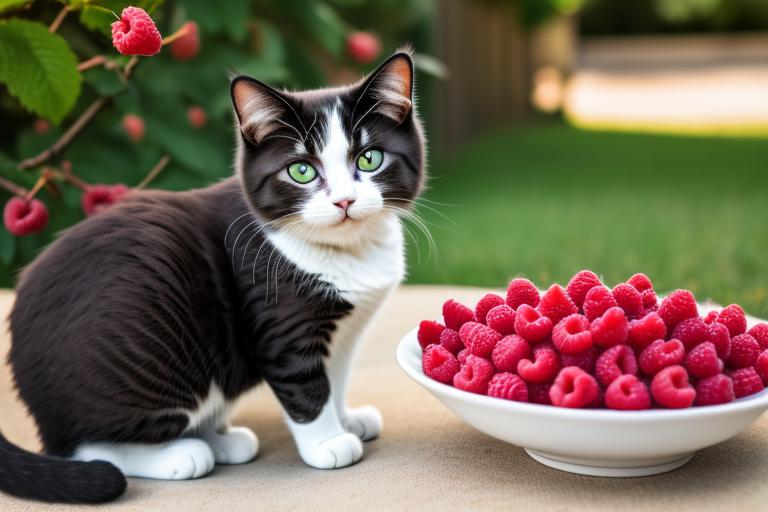Have you ever wondered if your feline companion can indulge in the juicy sweetness of raspberries? Well, the answer might surprise you.
While cats are obligate carnivores, meaning their diet primarily consists of meat, there are certain fruits that they can safely enjoy in moderation.
Raspberries happen to fall into that category, but before you start feeding them to your cat, there are a few important things you need to know.
So, let’s explore whether cats can eat raspberries and what precautions you should take to ensure their health and well-being.
Nutritional Benefits of Raspberries for Cats

Raspberries can be a healthy addition to your cat’s diet due to their numerous nutritional benefits. These small, juicy fruits are packed with vitamins, minerals, and antioxidants that can support your cat’s overall health.
One of the key nutritional benefits of raspberries is their high fiber content. Fiber helps promote healthy digestion and can prevent constipation in cats. Additionally, raspberries are rich in vitamin C, which is essential for a strong immune system. This vitamin can help your cat fight off infections and reduce the risk of developing chronic diseases. Raspberries also contain important minerals like manganese and potassium, which are necessary for proper nerve and muscle function.
Moreover, these berries are low in calories and fat, making them a great choice for cats who need to maintain a healthy weight. However, it’s important to note that raspberries should be given to cats in moderation, as too many can cause digestive upset.
As always, it’s best to consult with your veterinarian before introducing any new food to your cat’s diet.
Potential Risks and Allergies

If your cat has any existing allergies or sensitivities, it’s important to be cautious when introducing raspberries into their diet. While raspberries are generally considered safe for cats, there are a few potential risks and allergies to be aware of:
- Allergic Reactions: Some cats may have an allergic reaction to raspberries, resulting in symptoms such as itching, swelling, or gastrointestinal upset. If you notice any adverse reactions, it’s best to discontinue feeding your cat raspberries and consult with a veterinarian.
- Digestive Issues: Raspberries are high in fiber, which can cause digestive issues such as diarrhea or upset stomach if consumed in large quantities. It’s important to introduce raspberries gradually and in moderation to avoid any gastrointestinal disturbances.
- Pesticide Residues: If raspberries aren’t organic or properly washed, they may contain pesticide residues. These chemicals can be harmful to cats if ingested, so it’s crucial to thoroughly wash the raspberries before offering them to your furry friend.
- Choking Hazard: The small size of raspberries may present a choking hazard, especially for cats who tend to eat quickly without properly chewing. To prevent choking, it’s recommended to mash or puree the raspberries before feeding them to your cat.
- Weight Gain: Raspberries are relatively low in calories, but they still contain natural sugars. Feeding your cat too many raspberries can contribute to weight gain, so it’s important to make raspberries only a small part of their balanced diet.
Remember to always monitor your cat’s reactions and consult with a veterinarian before making any significant changes to their diet.
How to Introduce Raspberries to Your Cat

Now that you know cats can eat raspberries, it’s important to understand how to introduce them to your feline friend.
First, let’s discuss the benefits of raspberries for cats.
Next, we’ll cover the potential risks and allergies associated with feeding them this fruit.
Benefits of Raspberries
To introduce raspberries to your cat, start by offering small pieces as a tasty and healthy treat. Raspberries aren’t only delicious, but they also offer several benefits for your feline friend. Here are five reasons why you should consider adding raspberries to your cat’s diet:
- Rich in antioxidants: Raspberries are packed with antioxidants that can help boost your cat’s immune system and protect against diseases.
- High in fiber: The fiber content in raspberries can aid in digestion and promote a healthy digestive system for your cat.
- Hydration: Raspberries are made up of about 85% water, making them a great way to keep your cat hydrated.
- Low in calories: Raspberries are a low-calorie treat option for your cat, making them a healthy alternative to other snacks.
- Vitamin C: Raspberries are a good source of vitamin C, which can help support your cat’s overall health and well-being.
Remember to always introduce new foods gradually and consult with your veterinarian before making any major changes to your cat’s diet.
Risks of Feeding Raspberries
What are the potential risks of feeding raspberries to your cat and how should you introduce them?
While raspberries are generally safe for cats to eat, there are a few risks to be aware of. Firstly, raspberries contain small seeds that could pose a choking hazard for your cat. To minimize this risk, it’s best to mash or puree the raspberries before feeding them to your feline friend.
Secondly, raspberries are high in natural sugars, so feeding them in excess could lead to weight gain or digestive issues for your cat.
As with any new food, it’s important to introduce raspberries gradually into your cat’s diet. Start by offering a small amount and observe how your cat reacts. If there are no adverse reactions, you can slowly increase the serving size.
Remember to always consult your veterinarian before introducing any new food to your cat.
Proper Serving Size
When introducing raspberries to your cat, it’s important to consider the proper serving size to ensure their safety and enjoyment. Cats have different dietary needs than humans, so it’s crucial to feed them the right amount of raspberries. Here are some tips to help you introduce raspberries to your cat:
- Start with a small portion: Give your cat a few pieces of mashed raspberries to see how they react.
- Monitor for any adverse reactions: Watch out for any signs of digestive upset or allergies.
- Gradually increase the serving size: If your cat tolerates raspberries well, you can slowly increase the amount over time.
- Limit the quantity: Raspberries should only be given as an occasional treat and not as a regular part of your cat’s diet.
- Consult your veterinarian: If you have any concerns or questions, it’s always best to consult with your vet for guidance.
Recommended Portion Size for Cats
You should feed your cat an appropriate portion size to ensure their nutritional needs are met. Feeding your cat the right amount of food is crucial for their overall health and well-being.
Cats are obligate carnivores, which means they require a diet that’s high in animal protein and low in carbohydrates. It’s recommended to feed your cat a balanced diet that consists of high-quality commercial cat food.
The portion size will depend on factors such as your cat’s age, weight, activity level, and overall health. It’s important to follow the feeding guidelines provided by the cat food manufacturer. Typically, these guidelines will recommend a certain amount of food based on your cat’s weight.
It’s essential to monitor your cat’s weight and adjust the portion size accordingly to prevent under or overfeeding. Remember, portion size is just as important as the quality of food you provide.
Signs of Allergic Reaction in Cats
If your cat experiences an allergic reaction, there are several signs you should be aware of. Allergies in cats can manifest in various ways, and it’s crucial to recognize these symptoms to provide prompt medical attention.
Here are five signs of allergic reactions in cats:
- Itching and scratching: Excessive scratching, rubbing against furniture or walls, or constantly licking certain body parts can indicate an allergic reaction.
- Skin redness and inflammation: Allergic reactions can cause redness, inflammation, or the appearance of hives on your cat’s skin.
- Sneezing and coughing: Just like humans, cats can suffer from respiratory allergies, leading to sneezing, coughing, and even difficulty breathing.
- Vomiting and diarrhea: Allergies can also affect your cat’s digestive system, resulting in vomiting or diarrhea.
- Ear infections: Frequent ear infections, accompanied by discharge or foul odor, can be a sign of an allergic reaction.
It’s important to note that these signs may vary depending on the severity of the allergic reaction and the specific allergen involved. If you notice any of these symptoms in your cat, it’s recommended to consult a veterinarian for a proper diagnosis and appropriate treatment.
Other Fruits and Treats for Cats
Now let’s talk about other fruits and treats that are safe for your cat to enjoy.
There are some cat-friendly fruits, such as small pieces of apple or banana, that can be given as an occasional treat.
You can also try making healthy homemade cat treats using ingredients like cooked chicken or fish.
However, it’s important to be aware of certain fruits, like grapes and raisins, which should be strictly avoided as they can be toxic to cats.
Safe Cat-Friendly Fruits
Cats can enjoy a variety of safe and cat-friendly fruits as part of their diet. Here are five delicious options to consider:
- Apples: Cats can nibble on small pieces of apple, but make sure to remove the seeds and core, as they can be harmful.
- Blueberries: These tasty berries are packed with antioxidants and can be given as a healthy treat or mixed into your cat’s food.
- Watermelon: Cats can have a small amount of ripe watermelon as a refreshing snack, but avoid the rind and seeds.
- Bananas: Rich in potassium, bananas can be mashed and added to your cat’s meals for an extra boost of nutrients.
- Mango: Cats can enjoy small amounts of ripe mango for a tropical treat, but be sure to remove the skin and pit.
Healthy Homemade Cat Treats
When it comes to providing healthy homemade treats for your feline friend, there are plenty of other fruits and treats that can be safely incorporated into their diet. While cats are obligate carnivores and primarily rely on meat for their nutritional needs, there are certain fruits that can be given to them in moderation. Some examples include small pieces of watermelon, cantaloupe, or banana.
These fruits aren’t only safe for cats but also provide them with essential vitamins and minerals. However, it’s important to remember that treats should only make up a small portion of your cat’s diet. Additionally, there are commercially available cat treats that are specifically formulated to meet their nutritional requirements.
It’s always a good idea to consult with your veterinarian before introducing any new treats into your cat’s diet.
Fruits to Avoid
To ensure the health and well-being of your furry friend, it’s important to be aware of the fruits and treats that should be avoided in a cat’s diet. While cats may enjoy a variety of fruits, there are certain ones that can be harmful to their health. Here are five fruits and treats that you should avoid feeding your cat:
- Grapes and raisins: These can cause kidney failure in cats.
- Citrus fruits: Citrus fruits like oranges and lemons can cause gastrointestinal upset in cats.
- Avocado: The persin in avocados can be toxic to cats.
- Cherries: The pits and stems of cherries contain cyanide, which is poisonous to cats.
- Chocolate: Chocolate contains theobromine, which is toxic to cats and can cause seizures and even death.
Frequently Asked Questions
Yes, cats can eat strawberries as well. Strawberries are safe for cats in moderation. However, you should always remove the stems and leaves and cut them into small pieces to avoid choking hazards.
Yes, there are other fruits that your cat can safely eat. Some examples include bananas, blueberries, and watermelon. Just make sure to remove any seeds or pits and feed in moderation.
If your cat is experiencing an allergic reaction, look out for symptoms like itching, sneezing, difficulty breathing, or swollen face. It’s important to consult a vet for proper diagnosis and treatment.
You should not feed your cat raspberries. While they are not toxic, cats are obligate carnivores and do not have the digestive enzymes to properly break down fruits and vegetables.
There are potential risks and allergies associated with feeding cats raspberries. It’s important to introduce new foods slowly and watch for any adverse reactions. Consult with your veterinarian before offering raspberries to your cat.
Conclusion
In conclusion, while raspberries can provide some nutritional benefits for cats, it’s important to introduce them in moderation and watch for any signs of allergies or adverse reactions.
Always consult with your veterinarian before adding any new foods to your cat’s diet.
Remember, there are also other fruits and treats that can be safe and enjoyable for your feline friend.

